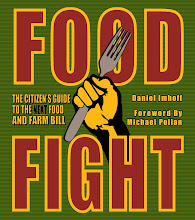 The Child Nutrition Act is up for reauthorization by September 30. This is a federal government policy that sets the rules and standards and uses tax dollars to—among other things—provide a daily reimbursement for school lunches. Right now this amounts to $2.57 for a free lunch, including labor and ingredients. It is nowhere close to what most school districts need to put healthy foods on our cafeteria tables and reward all the people who make that possible. Congress will soon consider adding one dollar per meal to the reimbursement, and this still might not be enough.
The Child Nutrition Act is up for reauthorization by September 30. This is a federal government policy that sets the rules and standards and uses tax dollars to—among other things—provide a daily reimbursement for school lunches. Right now this amounts to $2.57 for a free lunch, including labor and ingredients. It is nowhere close to what most school districts need to put healthy foods on our cafeteria tables and reward all the people who make that possible. Congress will soon consider adding one dollar per meal to the reimbursement, and this still might not be enough. Today’s National School Lunch Program, which is a major part of the five-year spending bill called the Child Nutrition Act, provides meals to 30 million children. Many young Americans depend on school meal and snack programs for a great majority of their daily caloric intake.
The NSLP was first made law in 1946, when our representatives—having survived a World War and a decade-long Great Depression—made a direct connection between the health of a nation and its children. They decided to officially establish a school lunch program at least in part for national security reasons. One out of three recruits in World War II had been turned away because of chronic malnutrition. Feeding students a proper school lunch was a national defense strategy.
Back in 1946 the idea was to support excess commodity agriculture that could then be used to feed children. But in the years since the mid-1940s, American agriculture underwent a transformation. Family farms gave way to a massive food industry that has flooded the market and our school lunch programs with intensively subsidized commodities and processed foods that are high in sugars, starches, and unhealthy fats and oils.
This cheap calorie delivery system—funded for the past few decades through both the Farm Bill and the Child Nutrition Act—has become a key player in a growing crisis: the Supersizing of our kids. One in four children are now overweight and obese. The projections for not addressing this situation—learning to eat better and adopt healthy lifestyles—are frightening. Future health care costs related to this nutritional epidemic could literally swamp local, state and federal government coffers in coming years. And that is just the financial perspective.
Often when we think of huge “omnibus” government legislations like the Transportation Bill, the Energy Bill, or the Farm Bill—huge public spending programs with real life consequences—they seem so complex and tedious it is hard to understand how they affect us personally. It’s easy to get lost in the billions and trillions, in the alphabet soup and acronyms, in highway projects and corn monocultures in the Midwest. One of the beauties of the National School Lunch Program is that we can see the impacts on a personal level. We can look around in our communities and see our kids who depend on these programs. The Child Nutrition Act touches home in every community around the country.
This year the US arm of the international movement known as Slow Food is circulating a petition asking for some very reasonable changes to the Child Nutrition Act:
• $1 increase in the reimbursement per meal;
• grants for Farm-to-School and school garden projects to educate every single child in the country on where food comes from, and get the culture back in agriculture;
• financial incentives for schools to purchase as many fruits and vegetables as possible from local farmers to keep that money in the community, and to shorten the distance our food has to travel before it reaches our children’s cafeteria tables.
All this makes sense and deserves our support if only for one single reason. Children need proper nutrition to be good students. They can’t make it through an afternoon of focused attention without healthy food. This is actually a national security concern. We can’t afford to be a nation of under-achievers, at least not if we can help it.
Fortunately, there is a great shift in consciousness occurring around food and public health right now. Locally grown healthy food is being seen as a catalyst and dynamic organizing principle to revitalize local economies, to compensate for a future with less oil, to deal with a planet that is heating up, to address an obesity crisis that is verging on disaster.
The concept of feeding all of our children well, of teaching them about the beauty and complexity of food production through school gardens and local Farm-to-School programs which actually feed them, should be a community as well as a national priority. But in order for these things to happen, Congress needs to authorize more funding for the program. We should see this long overdue increase to the Child Nutrition Act as a down payment on a new generation that will have a lifetime of good eating habits engrained in them. The idea of healthy foods as preventive health care—perhaps even as medicine—is a concept that can and should change the world.
Find Slow Food's petition here.
Find info on HR 1324, a bill introduced by Lynn Woolsey relating to Child Nutrition Act.
Dan Imhoff is the director of Watershed Media, publisher of the newly released book, "Smart By Nature," a collaborative project with the Center for Ecoliteracy.









